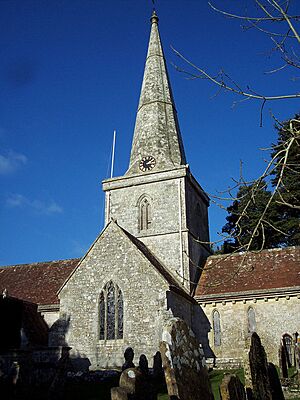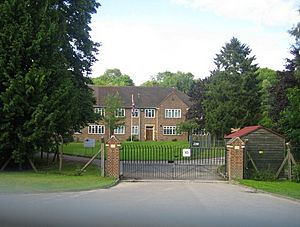Chilmark, Wiltshire facts for kids
Quick facts for kids Chilmark |
|
|---|---|
 |
|
| Population | 525 (in 2011) |
| OS grid reference | ST969327 |
| Unitary authority |
|
| Ceremonial county | |
| Region | |
| Country | England |
| Sovereign state | United Kingdom |
| Post town | Salisbury |
| Postcode district | SP3 |
| Dialling code | 01722 |
| Police | Wiltshire |
| Fire | Wiltshire |
| Ambulance | Great Western |
| EU Parliament | South West England |
| UK Parliament |
|
| Website | Parish Council |
Chilmark is a small village in Wiltshire, England. It is home to about 150 houses and sits along the B3089 road. The village is located about 11 kilometres (7 miles) west of Salisbury.
The area around Chilmark is known as a civil parish. This parish includes the smaller areas of Mooray and Portash, which are south of the main village. It also includes Ridge, a spread-out group of homes to the southwest. A stream flows through the village, often drying up in summer. It travels about 3 kilometres (2 miles) south to join the River Nadder.
Contents
History of Chilmark
People have lived in the Chilmark area for a very long time. Roman objects have been discovered in the local quarries. Stone from Chilmark, called Purbeck limestone, was likely used to build Roman houses in nearby villages like West Grimstead and Rockbourne.
It is thought that a church existed in Chilmark as early as the 12th century. Chilmark Manor, a large house near the church, was built in the 1600s and changed in the 1700s.
Places of Worship
The main church in Chilmark is called St. Margaret of Antioch. It is an Anglican parish church that was first built in the 13th century. More parts were added in the 14th and 18th centuries. The church was last repaired in 1856. Its tall tower was rebuilt around 1770 but still has original 13th-century windows.
The church's font (a basin for baptisms) has a 13th-century bowl on a newer base. Inside, you can see beautiful stained-glass windows from the 1800s. In 1966, the church was given a special status as a Grade II* listed building. This means it is a very important historic building. The churchyard also has old stone tombs from the 1600s and 1700s.
A small Baptist chapel was built in the Ridge area between 1851 and 1864. It became known as the Union chapel. By 2003, the building was no longer used as a chapel and was owned by private individuals.
Chilmark Ravine: Stone and Secrets
About 1.6 kilometres (1 mile) south of Chilmark village, a stream and a small road pass through a deep valley called a ravine. This area has been important for many reasons, from ancient stone quarries to secret defence sites in the 20th century. The western part of this ravine is actually in a different parish called Teffont.
Chilmark Quarries
Chilmark stone is a type of limestone that was dug out of the ground here for centuries. This special stone was used to build famous buildings, including Salisbury Cathedral. Stone digging continued on a small scale until the quarry closed around 2007. Similar stone is still mined nearby at Chicksgrove Quarry.
The old quarries are now protected as a Site of Special Scientific Interest. This means they are important for both their geology and their wildlife. They are also a European Special Area of Conservation because many bats live in the old quarry tunnels.
RAF Chilmark: A Secret Base
In 1936, the British Air Ministry bought the quarries and the land further down the ravine. This area became known as RAF Chilmark. It was home to No. 11 Maintenance Unit RAF, which was a place where military supplies, especially bombs and ammunition, were stored. These supplies were kept safe inside the quarry caverns. For a time, the unit also had large storage areas above ground in woodlands near Dinton and in Grovely Wood.
A special railway track was built to connect RAF Chilmark to the main London-Exeter railway line. This track was kept secret and was not shown on maps. Goods were moved from the standard-sized trains into a large shed. From there, they were loaded onto a smaller, narrow-gauge railway that ran into the ravine and some of the old quarry tunnels.
During World War II, RAF Chilmark was the largest place for storing ammunition in southern England. It played a very important role in the war effort. By 1965, it was the only ammunition supply depot left for the RAF. RAF Chilmark finally closed on January 27, 1995. However, it took until at least 1997 to safely remove all the explosives from the site.
A special diesel train from 1939 that was used at RAF Chilmark was later bought by the Bala Lake Railway in North Wales. Some of the old railway wagons are now at the Old Kiln Light Railway in Surrey.
What is there now?
In 1999, a report looked at what the former RAF site could be used for. It found that most of the site could not be easily reused. This was because of the large bat colonies living there and the chance that some contamination from the stored ammunition might still be present.
Until 2015, the former RAF headquarters and about 55 acres (0.22 square kilometres) of land in the ravine were used by a private company. This company used the area to train people in counter-terrorism security and how to handle explosives safely.
Underground Bunker
An underground bunker was built in the Chilmark ravine in 1985. This bunker was designed to be a Regional Government Headquarters (RGHQ) for the southwest region of England. Its purpose was to provide a safe place for government leaders to continue working in case of a nuclear attack.
However, the bunker stopped being used in 1992 after the end of the Cold War. It was then sold in 1997.
Villages with the Same Name
Interestingly, two places in the United States share the name Chilmark.
- Chilmark, Massachusetts, on the island of Martha's Vineyard, was named in 1694. This name was chosen because of Governor Thomas Mayhew, who moved from nearby Tisbury in Wiltshire and started a colony on the island.
- In 1930, a businessman named V. Everit Macy created a new suburb in Briarcliff Manor, New York. He named it Chilmark after the home village of his ancestor, Thomas Macy, who moved from England in 1635.
Village Life and Facilities
Chilmark has a primary school called Chilmark and Fonthill Bishop CofE (VA) Primary School. The school building was originally a National School, built with Chilmark stone in 1860. In 1971, the Chilmark school joined with the Fonthill Bishop school. The building at Fonthill Bishop closed, and the Chilmark school was made bigger.
The Reading Room, built in 1910, is now the village hall. This is a place where local events and meetings are held. The village also has a pub called the Black Dog Inn.
Famous People from Chilmark
- John Wilcox (1931–2018) was an author who lived in Chilmark. He wrote a series of 12 novels about a character named Simon Fonthill, as well as other books.
- Thomas Macy, an early settler of Amesbury, Massachusetts, and Nantucket Island in the United States, was born in Chilmark.
See also
 In Spanish: Chilmark (Wiltshire) para niños
In Spanish: Chilmark (Wiltshire) para niños





